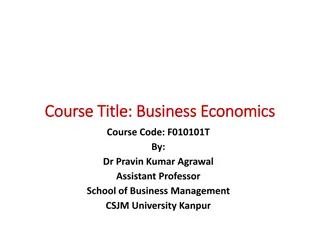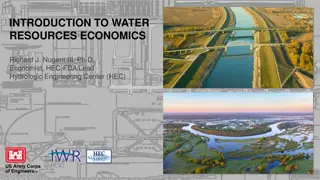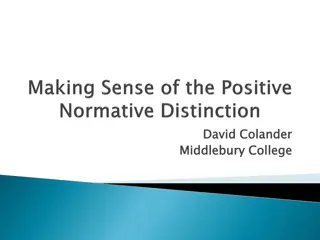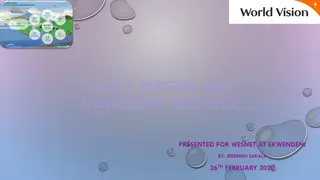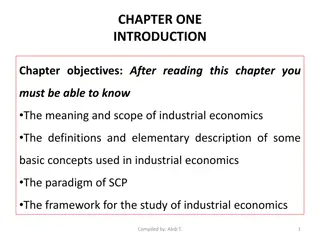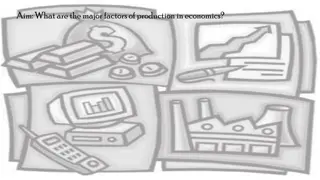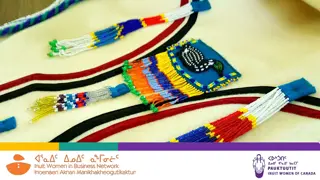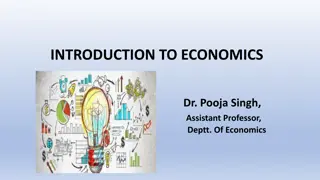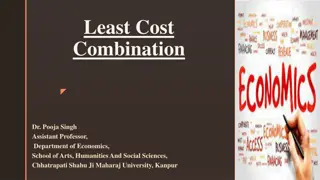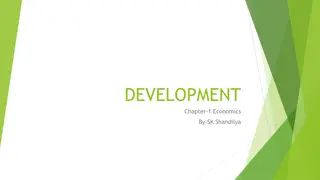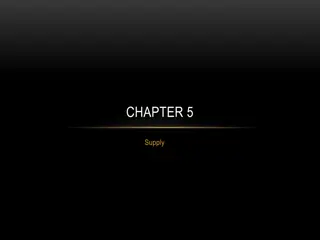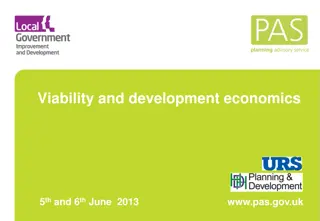Understanding Development Goals and Aspects in Economics
Development in economics encompasses positive growth in various aspects of life, such as economic, social, and political domains. Different categories of people have distinct developmental goals and aspirations. These goals may vary based on individual circumstances, leading to diverse perspectives on development. While income is a common goal, other important aspects include equality, freedom, security, and respect. This diversity in developmental goals highlights the complexity of achieving widespread development across different segments of society.
Download Presentation

Please find below an Image/Link to download the presentation.
The content on the website is provided AS IS for your information and personal use only. It may not be sold, licensed, or shared on other websites without obtaining consent from the author. Download presentation by click this link. If you encounter any issues during the download, it is possible that the publisher has removed the file from their server.
E N D
Presentation Transcript
ECONOMICS Std. X Chapter 1 (Development) By Mrs. Dharashree Padhi
Development is a positive growth or change in economical social and political aspects in the life of a person or in the country
DEVELOPMENT GOALS OF DIFFERENT CATEGORIES OF PERSONS Category of Person Development Goals/Aspirations 1. 2. More days of work and better wages; local school is able to provide education for their children; there is no social discrimination and they too can become leaders in the village again Landless rural laborers 3. 1. Assured a high family income through higher support prices for their crops and hardworking and cheap laborers They should be able to settle their children abroad Prosperous farers from Punjab 2. 1. For good and high production of crops better for better employment and for better wages Farmers who depend only on rain for growing crops 1. Better income, better education and cheap loans, Health cheap laborers A rural owner from a land owning family 1. He gets more freedom and can do whatever he wants and can study well in good schools A boy from a rich urban family 1. She gets as much freedom as her brother and is able to decide what she wants to do in life. She is able to pursue her studies abroad A girl from a rich urban family 2. 1. No social discrimination An Adivasi from Narmada valley
3 Aspects / Characteristics of Development :- Different developmental goals People tend to look at a mix of goals for their development What may be development for one may not be development for the other. It may be destructive for the other people can have different
Different People have different developmental goals because:- They have different aspirations and interests. It depends on the situation around them
What may be development for one may not be development for another for example:- To get more electricity industrialists may want more dams this developmental goal of industrialists may go against the goal of a tribal incase his land is submerged and his life maybe disturbed. A tribal may prefer to have a small check dam or tank to irrigate his land.
Income and other Goals:- Getting a better income is the major goal of all the people but besides income the other things that people might require are equal treatment freedom security respect of others. They resent discrimination.
How to compare different Countries or States? Per capita income or average income is the main criterion used by world bank to classify different countries or compare the countries Countries are classified into:- 1. Rich or Developed countries where the per capita income of US$ 12236 per annum 2. Poor or Underdeveloped countries where per capita income is US$ 1005 3. Middle income or Developing countries where the per capita income is in between US$12236 US$ 1005
Limitation of this criteria used by the World Bank:- Per capita income is affected by the size of the population of the country It does not tell us anything about distribution of income in the country It does not tell us anything about the availability of various services and facilities that income the quality of life
Besides income the other criteria that can be used for comparing he states in India are:- Infant Mortality Rate: indicates the number of children that die before the age of one year as a proportion of 1000 live children born in that particular year Literacy Rate: measures the portion of literate population in the 7 and above age group Net Attendance Ratio: is the total number of children of age group 6-10 attending school as a percentage of total number of children in the same age group
National Development:- It refers to the ability of a country to improve the social welfare of the people. For example, by providing public facilities like quality education, portable water, transportation, infrastructure, medical care, public distribution, etc. These public facilities need to be collectively looked after in order to enjoy it in a better way Money in your pocket cannot buy all goods and services that you may need to live. For example, 1. Money cannot buy you a pollution free environment 2. It cannot ensure that you get unadulterated medicines 3. It may not be able to protect you from infectious diseases Therefore, for a better life collective effort of the community is necessary
Human Development Index World Bank report compares countries with only average income which has many limitations so UNDP published the Human Development report This report compares the countries using 3 variables:- 1. Per Capita Income 2. Health of People 3. Their Level of Education These 3 criteria's ranks the countries through the Human Development Index
Health facilities of the countries are assessed through:- 1. Life expectancy at birth- average expected length of life of a person at the time of birth Education facilities of the countries are assessed through 1. Literacy rate for 15+ years population Per capita income is calculated in dollars for all countries so that it can be compared
Sustainability of Development and its Importance:- Sustainable development refers to the development which takes place without hampering the needs of the future generation it means attending today s needs without compromising the needs of the future The resources available on Earth are in plenty but this needs to be used judiciously in order to save it for the future The ways through which resources can be used judiciously are:- a) Stress on developing techniques b) Use of alternative source of resources c) Effective steps to recycle used resources
The issue of sustainability is essential because:- 1. It helps in conserving environment 2. It protects the people against pollution and dentures the quality of their life 3. It raises the standard of the living of the existing population 4. If available resources are misused then development will stagnate after a period of time
For further reference: https://www.youtube.com/watch? v=h0KxUWVP5bA https://www.youtube.com/watch? v=0AKAPfWTnRc


